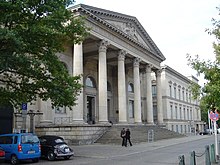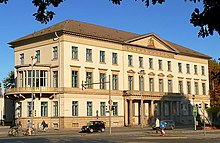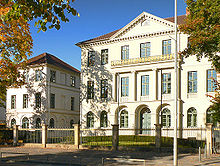Georg Ludwig Friedrich Laves








Georg Ludwig Friedrich Laves (17 December 1788 – 30 April 1864) was a German architect, civil engineer and urban planner. Born in Uslar, Lower Saxony, he lived and worked most time in the city of Hanover and also died there. Being the leading architect (since 1852 Oberhofbaudirektor, "court master builder") of the Kingdom of Hanover, he has had great influence on the urban development of this town. Laves was, beside Karl Friedrich Schinkel in Prussia and Leo von Klenze in Bavaria, one of the most renowned neoclassical style architects of Germany. As an engineer he developed a special bridge construction principle with a typical fish belly design, the so-called "Lavesbrücke". Laves has found his last resting place at Engesohde Cemetery (Engesohder Friedhof) in Hanover.
Among his most important works are:
- Fully re-built of the Leineschloss (Leine Palace or Leine Castle), between 1816 and 1844 (badly damaged in World War II and again re-built by Dieter Oesterlen between 1957 and 1962).
- Hanover Opera House, home base of Staatsoper Hannover, built between 1845 and 1852 (badly damaged in World War II and re-built in 1948).
- Wangenheim palace for Count Georg von Wangenheim, built between 1829 and 1832.
- Facade of Herrenhausen Castle (Schloss Herrenhausen) in neoclassical style, about 1820/21 (destroyed in World War II)
- Palmenhaus ("Palm-house"), a conservatory, built between 1846 and 1849. The building housed the most valuable and extensive collection of palms in all of Europe. It was located in the Berggarten, but is destroyed.
- Mausoleum for king Ernest Augustus I of Hanover and his wife Frederica of Mecklenburg-Strelitz in the garden of the Chapel at Schloss Herrenhausen (the mausoleum today is situated in the Berggarten, part of the Herrenhausen Gardens), built between 1842 an 1847.
- Waterloo Place with Waterloo Column, built between 1826 and 1832.
- Some structures designed or remodeled in the landscape garden around the Derneburg Castle near Hildesheim, owned by Count Ernst zu Münster
